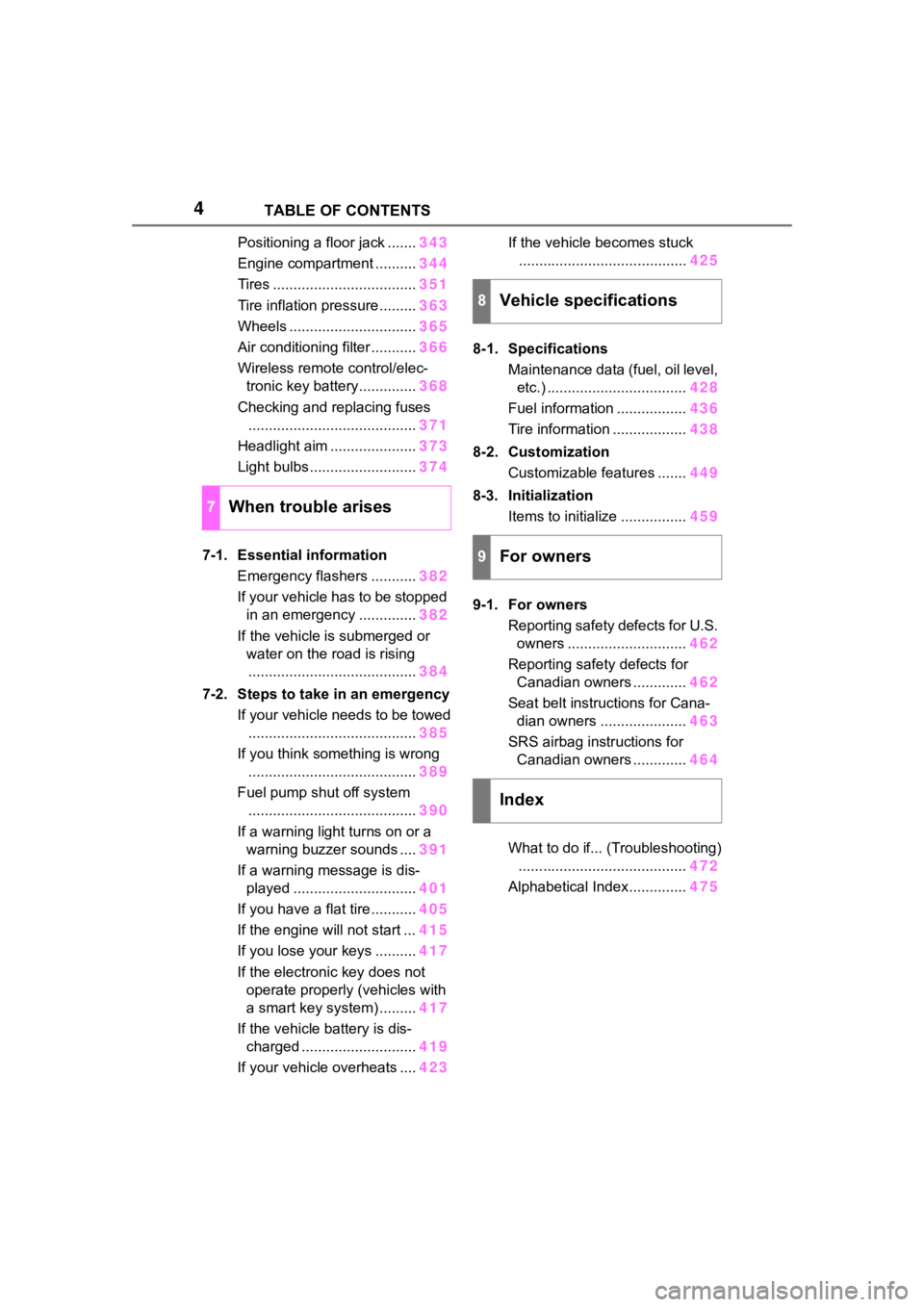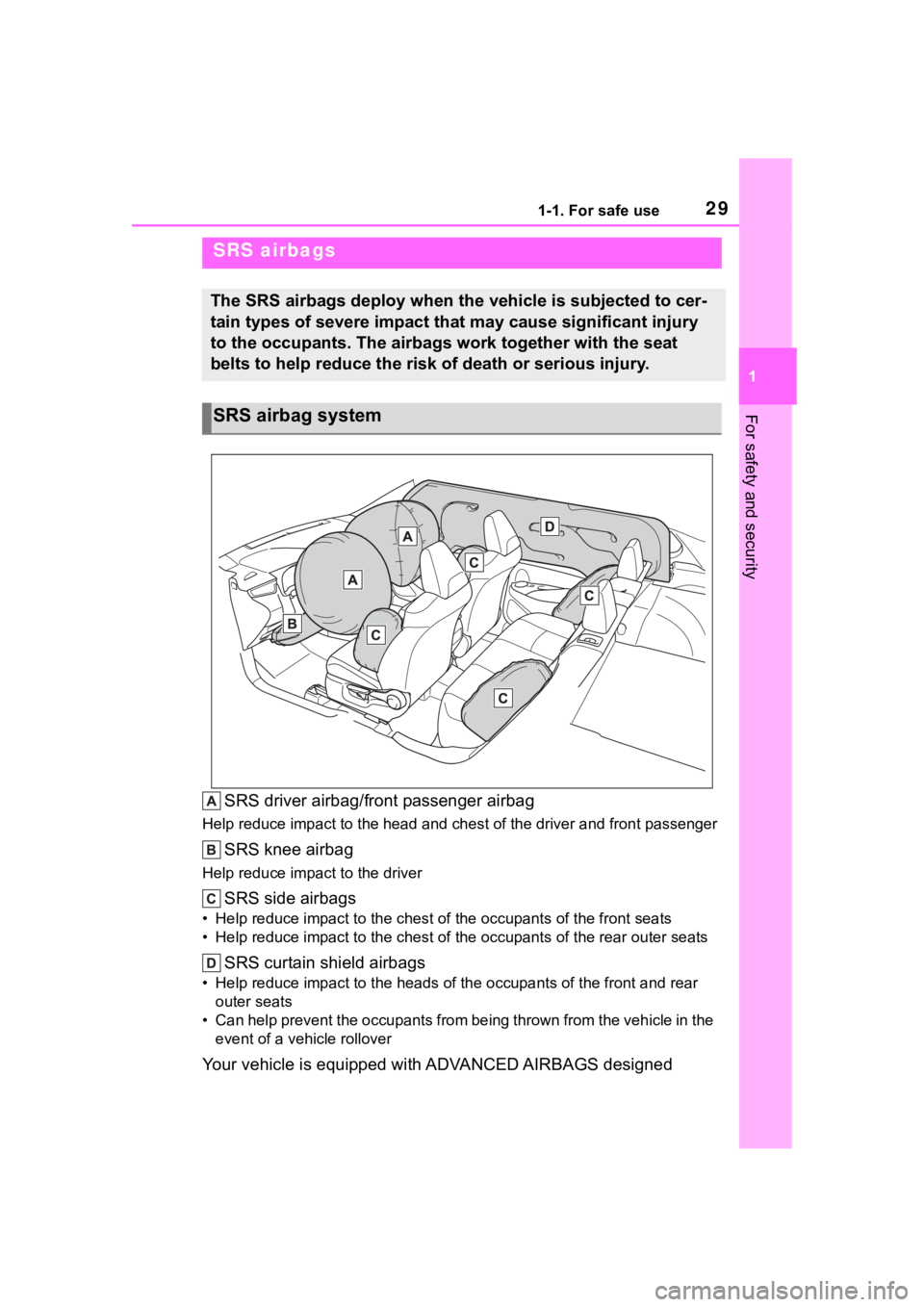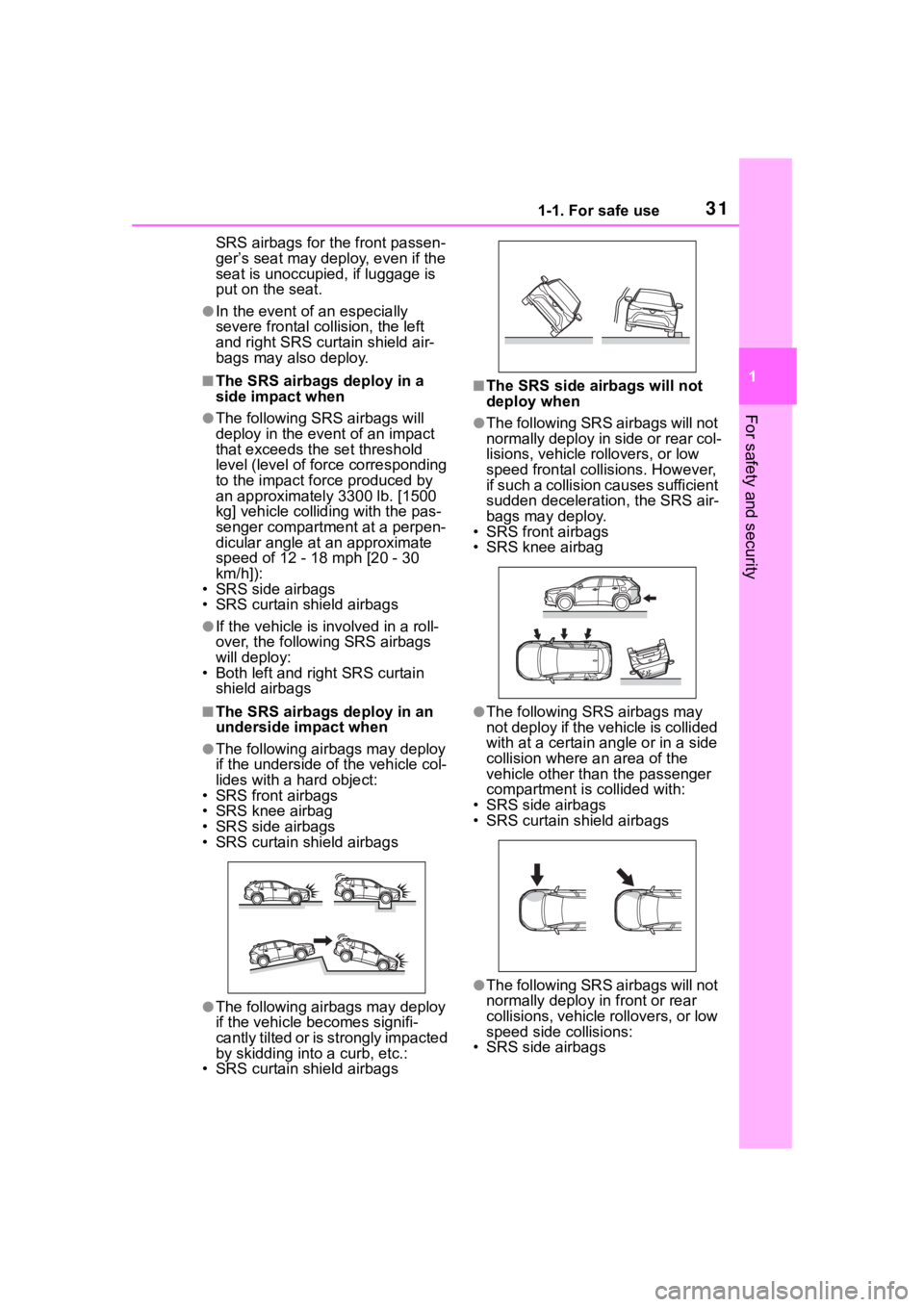airbag TOYOTA COROLLA CROSS 2023 Owners Manual
[x] Cancel search | Manufacturer: TOYOTA, Model Year: 2023, Model line: COROLLA CROSS, Model: TOYOTA COROLLA CROSS 2023Pages: 500, PDF Size: 15.11 MB
Page 1 of 500

1
2
3
4
5
6
7
8
9
COROLLA CROSS_MTMUS_U
Pictorial indexSearch by illustration
For safety
and securityMake sure to read through them
(Main topics: Child seat, theft deterrent system)
Vehicle status
information and
indicatorsReading driving-related information
(Main topics: Meters, multi-information display)
Before drivingOpening and closing the doors and windows,
adjustment before driving
(Main topics: Keys, doors, seats)
Driving
Operations and advice which are necessary for
driving
(Main topics: Starting engine
Interior featuresUsage of the interior features
(Main topics: Air conditioner, storage features)
Maintenance
and careCaring for your vehicle and maintenance
procedures
(Main topics: Interior and exterior, light bulbs)
When trouble
arisesWhat to do in case of malfunction and emergency
(Main topics: Battery discharge, flat tire)
Vehicle
specificationsVehicle specifications, customizable features
(Main topics: Fuel, oil, tire inflation pressure)
For ownersReporting safety defects for U.S. owners, and seat
belt, SRS airbag and headlight aim instructions for
Canadian owners
IndexSearch by symptom
Search alphabetically
Page 2 of 500

2TABLE OF CONTENTS
For your information ........................5
Reading this manual ...................... 11
How to search ................................ 12
Pictorial index ................................ 13
1-1. For safe use Before driving ........................ 22
For safe driving ..................... 23
Seat belts .............................. 25
SRS airbags .......................... 29
Front passenger occupant clas- sification system.................. 37
Exhaust gas precautions....... 41
1-2. Child safety Riding with children ............... 42
Child restraint systems .......... 43
1-3. Emergency assistance Safety Connect ..................... 64
1-4. Theft deterrent system Engine immobilizer system ... 68
Alarm ..................................... 69
2-1. Instrument cluster Warning lights and indicators............................................ 72
Gauges and meters (4.2-inch display)................................ 76
Gauges and meters (7-inch dis- play) .................................... 79
Multi-information display (4.2-inch display)................. 82
Multi-information display (7-inch display)................................ 89
Fuel consumption information ............................................ 953-1. Key information
Keys ...................................... 98
3-2. Opening, closing and locking the doors
Side doors .......................... 103
Back door ........................... 108
Smart key system .............. 118
3-3. Adjusting the seats Front seats ......................... 123
Rear seats.......................... 124
Head restraints................... 126
3-4. Adjusting the steering wheel and mirrors
Steering wheel ................... 128
Inside rear view mirror ....... 129
Outside rear view mirrors ... 130
3-5. Opening and closing the win- dows
Power windows .................. 132
Moon roof ........................... 135
3-6. Favorite settings My Settings ........................ 138
4-1. Before driving Driving the vehicle.............. 141
Cargo and luggage ............ 147
Vehicle load limits .............. 150
Trailer towing...................... 151
Dinghy towing .................... 161
4-2. Driving procedures Engine (ignition) switch (vehicles without a smart key system)........ ................................. 162
Eng
ine (ignition) switch (vehicles
with a smart key system) . 163
1For safety and security
2Vehicle status information
and indicators
3Before driving
4Driving
Page 4 of 500

4TABLE OF CONTENTS
Positioning a floor jack .......343
Engine compartment .......... 344
Tires ................................... 351
Tire inflation pressure......... 363
Wheels ............................... 365
Air conditioning filter ........... 366
Wireless remote control/elec- tronic key battery.............. 368
Checking and replacing fuses ......................................... 371
Headlight aim ..................... 373
Light bulbs .......................... 374
7-1. Essential information Emergency flashers ........... 382
If your vehicle has to be stopped in an emergency .............. 382
If the vehicle is submerged or water on the road is rising......................................... 384
7-2. Steps to take in an emergency If your vehicle needs to be towed......................................... 385
If you think something is wrong ......................................... 389
Fuel pump shut off system ......................................... 390
If a warning light turns on or a warning buzzer sounds .... 391
If a warning message is dis- played .............................. 401
If you have a flat tire ........... 405
If the engine will not start ... 415
If you lose your keys .......... 417
If the electronic key does not operate properly (vehicles with
a smart key system) ......... 417
If the vehicle battery is dis- charged ............................ 419
If your vehicle overheats .... 423If the vehicle becomes stuck
......................................... 425
8-1. Specifications Maintenance data (fuel, oil level, etc.) .................................. 428
Fuel information ................. 436
Tire information .................. 438
8-2. Customization Customizable features ....... 449
8-3. Initialization Items to initialize ................ 459
9-1. For owners Reporting safety defects for U.S. owners ............................. 462
Reporting safety defects for Canadian owners ............. 462
Seat belt instructions for Cana- dian owners ..................... 463
SRS airbag instructions for Canadian owners ............. 464
What to do if... (Troubleshooting) ......................................... 472
Alphabetical Index.............. 475
7When trouble arises
8Vehicle specifications
9For owners
Index
Page 6 of 500

6
may work in situations where it
should not be working.
Installing electronic devices and
radios increases the risk of
cyber attacks through the
installed parts, which may lead
to unexpected accidents and
leakage of personal informa-
tion. Toyota does not make any
guarantees for problems caused
by installing non-genuine Toyota
products.
The installation of a mobile
two-way radio system in your
vehicle could affect electronic
systems such as:
Multiport fuel injection sys-
tem/sequential multiport fuel
injection system
Toyota Safety Sense 3.0
Anti-lock brake system
SRS airbag system
Seat belt pretensioner system
Be sure to check with your Toy-
ota dealer for precautionary
measures or special instructions
regarding installation of a mobile
two-way radio system. This vehicle is equipped with
sophisticated computers that
record certain data regarding
vehicle controls and operations.
Data recorded by the comput-
ers
*1
Certain data, such as the following,
is recorded dependi ng on the oper-
ation timing and status of each
function.
• Basic vehicle behavior related data (engine speed, accelera-
tor/brake pedal operation, vehi-
cle speed, etc.)
• Operating state of the driving support systems (recorded during
system operation, includes basic
vehicle behavior related data)
• Driving support system sensor data
• Image data (images from the front, rear and side cameras)
*2
• Location information
These computers do not record
conversations, sounds, or
images of the inside of the vehi-
cle.
Also, personal information which
may be used to identify the
owner of the vehicle (name,
gender, age, etc.) is not
recorded.
Usage of recorded data and
personal information by the
Toyota Safety Sense 3.0
Cyber Attack Risk
Installation of a mobile
two-way radio system
Vehicle data recording
Page 9 of 500

9
buckled/fastened;
• How far (if at all) the driver was depressing the accelera-
tor and/or brake pedal; and,
• How fast the vehicle was trav- eling.
These data can help provide a
better understanding of the cir-
cumstances in which crashes
and injuries occur.
NOTE: EDR data are recorded
by your vehicle only if a non-triv-
ial crash situation occurs; no
data are recorded by the EDR
under normal driving conditions
and no personal data (e.g.,
name, gender, age, and crash
location) are recorded. How-
ever, other parties, such as law
enforcement, could combine the
EDR data with the type of per-
sonally identifying data rou-
tinely acquired during a crash
investigation.
To read data recorded by an
EDR, special equipment is
required, and access to the
vehicle or the EDR is needed. In
addition to the vehicle manufac-
turer, other parties, such as law
enforcement, that have the spe-
cial equipment, can read the
information if they have access
to the vehicle or the EDR.
Disclosure of the EDR data
Toyota will not disclose the data
recorded in an EDR to a third party
except when:
• An agreement from the vehicle’s owner (or the lessee for a leased
vehicle) is obtained
• In response to an official request by the police, a court of law or a
government agency
• For use by Toyota in a lawsuit
However, if necessary, Toyota may:
• Use the data for research on vehicle safety performance
• Disclose the data to a third party for research pur poses without
disclosing information about the
specific vehicle or vehicle owner
The SRS airbag and seat belt
pretensioner devices in your
Toyota contain explosive chemi-
cals. If the vehicle is scrapped
with the airbags and seat belt
pretensioners left as they are,
this may cause an accident such
as fire. Be sure to have the sys-
tems of the SRS airbag and seat
belt pretensioner removed and
disposed of by a qualified ser-
vice shop or by your Toyota
dealer before you scrap your
vehicle.
Special handling may apply, See
www.dtsc.ca.gov/
hazardouswaste/perchlorate.
Your vehicle has components
that may contain perchlorate.
These components may include
the airbags, seat belt preten-
Scrapping of your Toyota
Perchlorate Material
Page 19 of 500

19Pictorial index
■Interior
SRS airbags .................................................... ...................... P.29
Floor mats..................................................... ........................ P.22
Front seats .................................................... ...................... P.123
Head restraints ................................................ ................... P.126
Seat belts ..................................................... ......................... P.25
Console box ....................................................................... P.306
Inside lock buttons ............................................ ................ P.107
Cup holders .................................................... .................... P.305
Rear seats ..................................................... ...................... P.124
Page 21 of 500

21
1
1
For safety and security
For safety and security
.1-1. For safe useBefore driving ................. 22
For safe driving .............. 23
Seat belts ....................... 25
SRS airbags ................... 29
Front passenger occupant classification system .... 37
Exhaust gas precautions ..................................... 41
1-2. Child safety Riding with children ........ 42
Child restraint systems... 43
1-3. Emergency assistance Safety Connect .............. 64
1-4. Theft deterrent system Engine immobilizer system..................................... 68
Alarm.............................. 69
Page 29 of 500

291-1. For safe use
1
For safety and security
SRS driver airbag/front passenger airbag
Help reduce impact to the head and chest of the driver and front passenger
SRS knee airbag
Help reduce impact to the driver
SRS side airbags
• Help reduce impact to the chest of the occupants of the front seats
• Help reduce impact to the chest of the occupants of the rear o uter seats
SRS curtain shield airbags
• Help reduce impact to the heads of the occupants of the front and rear
outer seats
• Can help prevent the occupants from being thrown from the vehi cle in the
event of a vehicle rollover
Your vehicle is equipped with ADVANCED AIRBAGS designed
SRS airbags
The SRS airbags deploy when the vehicle is subjected to cer-
tain types of severe impact that may cause significant injury
to the occupants. The airbags work together with the seat
belts to help reduce the risk of death or serious injury.
SRS airbag system
Page 30 of 500

301-1. For safe use
based on US motor vehicle safety standards (FMVSS208). The air-
bag sensor assembly (ECU) controls airbag deployment based on
information obtained from the sensors, etc., shown in the system
components diagram above. This in formation includes crash sever-
ity and occupant information. As the airbags deploy, a chemical
reaction in the inflators quickly fills the airbags with non-toxic gas to
help restrain the motion of the occupants.
■If the SRS airbags deploy
(inflate)
●Slight abrasions, burns, bruising,
etc., may be sustained from SRS
airbags, due to the extremely high
speed of deployment (inflation) by
hot gases.
●A loud noise and white powder will
be emitted.
●Parts of the airbag module (steer-
ing wheel hub, airbag cover and
inflator) as well as the parts
around the airbags may be hot for
several minutes. T he airbag itself
may also be hot.
●The windshield may crack.
●All of the doors will be unlocked.
( P.105)
●The brakes and st op lights will be
controlled automatically. ( P.275)
●The interior lights will turn on auto-
matically. ( P.303)
●The emergency flashers will turn
on automatically. ( P.382)
●Fuel supply to the engine will be
stopped. (P.390)
●For Safety Connect subscribers, if
any of the followin g situations
occur, the system is designed to
send an emergency call to the
response center, notifying them of
the vehicle’s location (without
needing to push the “SOS” button)
and an agent will attempt to speak
with the occupants to ascertain
the level of emergency and assis-
tance required. If the occupants
are unable to communicate, the
agent automatically treats the call as an emergency and helps to dis-
patch the necessary emergency
services. (
P. 6 4 )
• When an SRS airbag has been
deployed
• When a seat belt pretensioner has operated
• When the vehicle has been involved in a severe rear-end colli-
sion
■The SRS airbags deploy in a
frontal impact when
●The following SRS airbags will
deploy in the event of an impact
that exceeds a th reshold level
(level of force corresponding to an
approximately 12 - 18 mph [20 -
30 km/h] frontal collision with a
fixed wall that does not move or
deform):
• SRS front airbags
• SRS knee airbag
●The threshold level at which the
SRS airbags will deploy will be
higher than normal in the in the
following situations:
• When the vehicle collides with an
object, such as a parked vehicle
or sign pole, which moves or
deforms on impact
• If the vehicle is involved in an underride collision, such as a colli-
sion in which the front of the vehi-
cle “underrides”, or goes under,
the bed of a truck
●Depending on the type of collision,
only the following may deploy:
• Seat belt pretensioners
●The SRS airbags for the front pas-
senger’s seat will not deploy if
there is no passe nger in the front
passenger seat. However, the
Page 31 of 500

311-1. For safe use
1
For safety and security
SRS airbags for the front passen-
ger’s seat may deploy, even if the
seat is unoccupied, if luggage is
put on the seat.
●In the event of an especially
severe frontal collision, the left
and right SRS curtain shield air-
bags may also deploy.
■The SRS airbags deploy in a
side impact when
●The following SRS airbags will
deploy in the event of an impact
that exceeds the set threshold
level (level of force corresponding
to the impact force produced by
an approximately 3300 lb. [1500
kg] vehicle collid ing with the pas-
senger compartment at a perpen-
dicular angle at an approximate
speed of 12 - 18 mph [20 - 30
km/h]):
• SRS side airbags
• SRS curtain shield airbags
●If the vehicle is involved in a roll-
over, the following SRS airbags
will deploy:
• Both left and right SRS curtain shield airbags
■The SRS airbags deploy in an
underside impact when
●The following airbags may deploy
if the underside of the vehicle col-
lides with a hard object:
• SRS front airbags
• SRS knee airbag
• SRS side airbags
• SRS curtain shield airbags
●The following airbags may deploy
if the vehicle becomes signifi-
cantly tilted or is strongly impacted
by skidding into a curb, etc.:
• SRS curtain shield airbags
■The SRS side airbags will not
deploy when
●The following SRS airbags will not
normally deploy in side or rear col-
lisions, vehicle rollovers, or low
speed frontal collisions. However,
if such a collision causes sufficient
sudden deceleration, the SRS air-
bags may deploy.
• SRS front airbags
• SRS knee airbag
●The following SRS airbags may
not deploy if the vehicle is collided
with at a certain angle or in a side
collision where an area of the
vehicle other than the passenger
compartment is collided with:
• SRS side airbags
• SRS curtain shield airbags
●The following SRS airbags will not
normally deploy in front or rear
collisions, vehicle rollovers, or low
speed side collisions:
• SRS side airbags